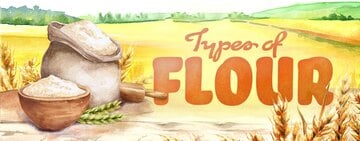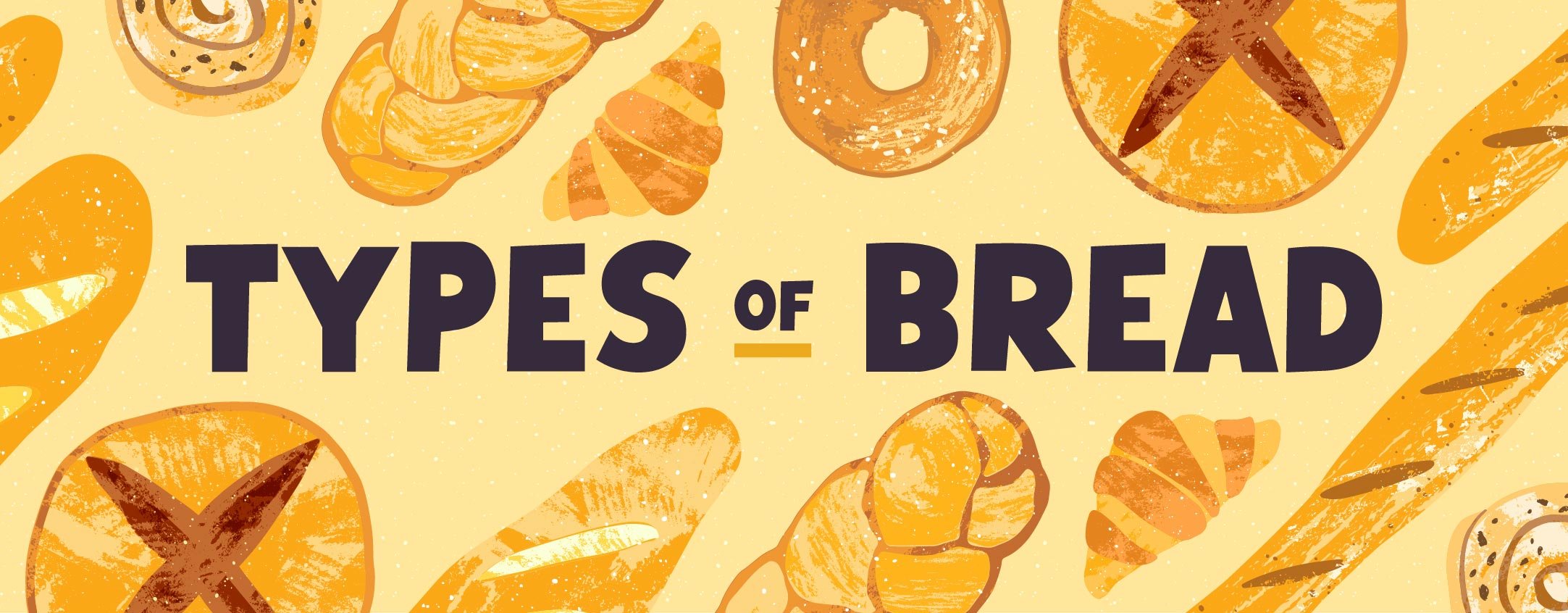
Bread combines four simple and inexpensive ingredients (flour, water, yeast, and salt) to make one of the world’s longest-standing foods in almost every culture. Whether you’re just getting into bread-baking or you’re starting a bakery and need menu ideas, check out these bread types to expand your repertoire.
Shop All BreadDifferent Types of Bread
There are a lot of different breads to know about, so we listed out the most common bread types below.
1. Arepa
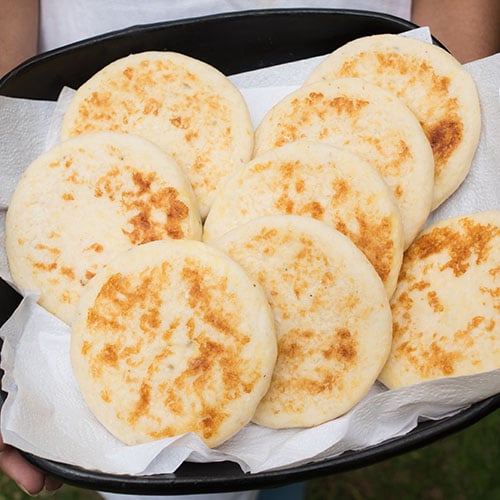
Arepas are flat and circular breads made from masa, water, and salt and cooked in butter or oil. They are usually pan-fried or griddled, cut in half horizontally, and used as sandwich bread.
Arepas originated in the northern region of South America which includes Venezuela, Colombia, and Panama. They're usually cut in half and stuffed with cheese, beans, pork, chicken, steak, onions, avocado, or plantains. Arepas are great to sell year-round but they make an especially great Hispanic Heritage Month menu item.
- Arepas Origin: Venezuela, Colombia, and Panama
- Arepa Ingredients: Masa, water, and salt
- How to Eat Arepas: Cut in half and layered with food
2. Baguette
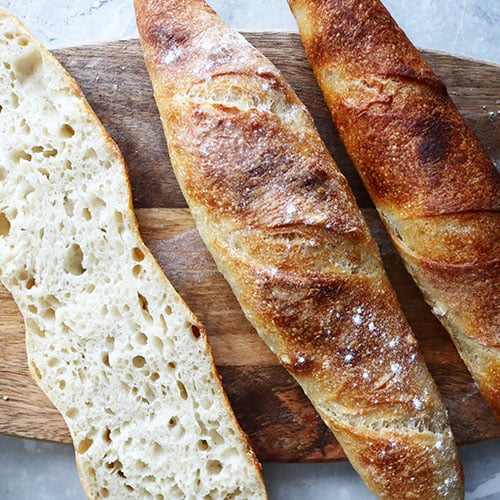
Baguettes are long, cylindrical loaves of bread made from flour, water, yeast, and salt. Thanks to steam ovens, baguettes have a thin and crispy crust and pillowy interior. Baguettes originated in France, and their legacy has had such an impression on the world that UNESCO granted it World Heritage Status in 2022.
Baguettes are typically cut into rounds or sliced in half horizontally and eaten with butter, cheese, or cured meats. They also make a great bread option to use on a charcuterie board or with a butter board.
- Baguette Origin: France
- Baguette Ingredients: Flour, water, yeast, and salt
- How to Eat Baguettes: Eaten with butter, cheese, and cured meats, or alongside charcuterie boards and butter boards
3. Bagel
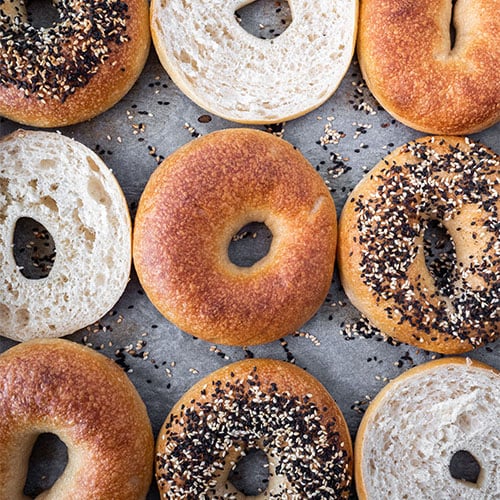
A bagel is a type of bread that is shaped into an “O” with a hole in the middle. Bagels are made of flour, yeast, water, salt, and barley malt syrup. This thick and fluffy bread is cooked twice: first boiled, then baked. There are a lot of conflicting opinions on where bagels first originated, but many people believe bagels were first made by Jews in Poland.
They can be eaten plain, cut in half and smeared with cream cheese, or made into a sandwich. Popular bagel toppings include savory foods like cream cheese, butter, smoked salmon, tomatoes, cucumbers, and onions. Sweet bagel toppings include nut butter, fruit, and honey.
- Bagel Origin: Poland
- Bagel Ingredients: Flour, yeast, water, salt, and barley malt syrup
- How to Eat Bagels: As a sweet or savory open-faced toast-like meal or as a breakfast sandwich
4. Brioche

Brioche is a type of French bread that has a tender, fluffy, and rich interior. Brioche contains flour, yeast, salt, butter, sugar, eggs, milk, and sometimes brandy. Because of the proteins and sugars present in the enriched dough, brioche tends to have a soft but very dark crust thanks to the Maillard reaction that takes place with these ingredients.
Brioche is great as a piece of sliced bread served with butter or jam. It also makes excellent dinner rolls, hamburger buns, and hot dog rolls. If your brioche is a bit dried out, we recommend using it to make French toast. While brioche is bread, its sweet taste has also made it be considered a French pastry.
- Brioche Origin: France
- Brioche Ingredients: Flour, yeast, salt, butter, sugar, eggs, milk, and sometimes brandy
- How to Eat Brioche: Dinner rolls, hamburger buns, hot dog rolls, French toast, or as a slice of bread served with butter or jam
5. Ciabatta
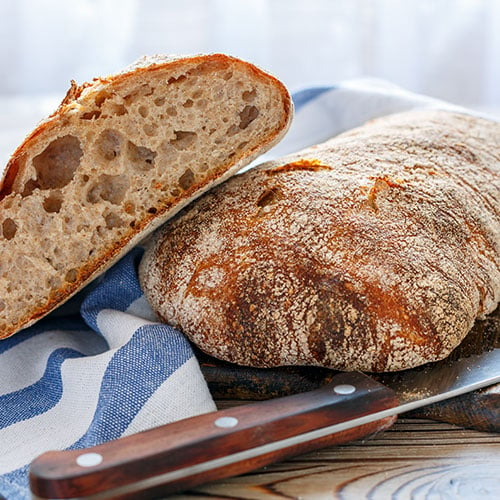
Ciabatta, pronounced “chya-baht-ah”, is a type of bread that originated in 1982 in Veneto, Italy. Ciabatta, meaning “slipper” in Italian, was inspired by the baguette’s popularity, but instead made into a slipper-shape instead of the baguette’s famous cylindrical shape with tapered ends.
Ciabatta is made simply with just flour, yeast, salt, and water, resulting in a chewy interior with large holes and a rustic and flaky crust. This bread is perfect for making garlic bread, sandwiches, and paninis. It also makes great table bread to serve alongside olive oil and parmesan.
- Ciabatta Origin: Veneto, Italy
- Ciabatta Ingredients: Flour, yeast, salt, and water
- How to Eat Ciabatta: Garlic bread, sandwiches, paninis, and as table bread
6. Challah
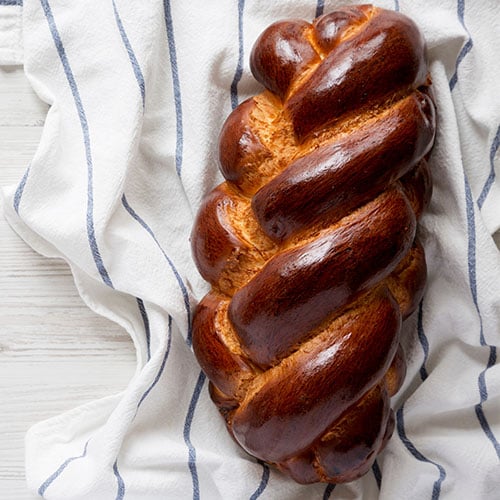
Challah bread (pronounced haah-luh) is a type of bread that’s meticulously braided into a beautiful loaf. Challah is an enriched bread made from flour, water, yeast, salt, sugar or honey, vegetable oil, and eggs, giving challah a fluffy interior and dark golden-brown crust that’s soft and flavorful.
Challah was made by Ashkenazi Jews in Central and Eastern Europe as well as Israel. Challah bread is typically made and eaten on major Jewish holidays or ceremonial occasions like Shabbat. You can also eat challah bread sliced and spread with butter and jam, or use challah bread for French toast or bread pudding.
- Challah Origin: Israel and Central and Eastern Europe
- Challah Ingredients: Flour, water, yeast, salt, sugar or honey, vegetable oil, and eggs
- How to Eat Challah: Sliced and spread with butter and jam or used for French toast or bread pudding
7. English Muffin
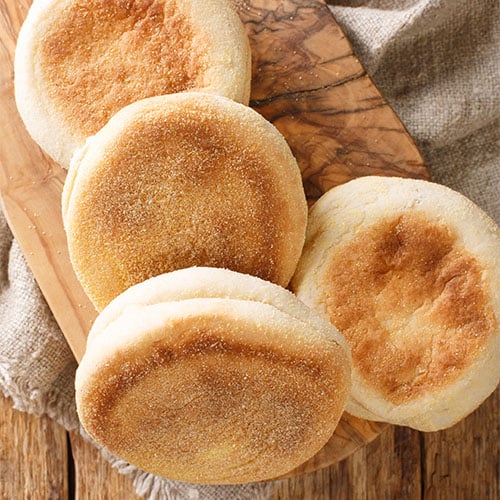
English muffins are round, flat, and small bread. They were made in America by an English baker who was one of the early colonizers during the 1800s. English muffins are made with whole wheat flour, water, salt, sugar, butter, and cornmeal and are leavened with either yeast or sourdough starter, creating big pockets of air on the inside.
English muffins do not bake in the oven like other types of bread but instead are cooked in a pan on the stovetop. After cooking, English muffins are best when cut in half horizontally, toasted, and slathered in butter and jam. They’re also known to be a great breakfast menu item, being the bread base for eggs benedict and breakfast sandwiches.
- English Muffins Origin: America
- English Muffin Ingredients: Whole wheat flour, yeast or sourdough starter, water, salt, sugar, butter, and cornmeal
- How to Eat English Muffins: Toasted and slathered in butter and jam, the bread base for eggs benedict, and bread for sandwiches
8. Focaccia
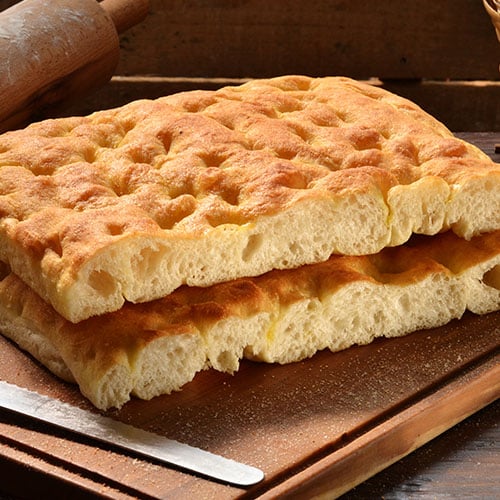
Focaccia is a type of Italian bread that is similar in texture and flavor to pizza but is much thicker. It's made with flour, water, yeast, salt, olive oil, and honey. Many people add herbs and spices to the bread to make it unique.
Focaccia does not bake with a dome as most bread does but instead bakes flat and is usually around 2 inches tall. Focaccia bread can be eaten simply alongside good olive oil. It’s also great cut in half horizontally and made into a sandwich or panini.
- Focaccia Origin: Italy
- Focaccia Ingredients: Flour, water, yeast, salt, olive oil, and honey
- How to Eat Focaccia: Alongside olive oil or made into a panini
9. Hokkaido
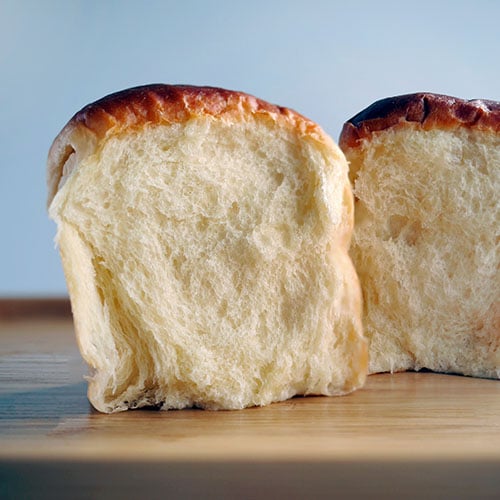
Hokkaido milk bread is a type of bread that originated in the Hokkaido region of Japan. It uses the tangzhong cooking technique, which calls for pre-cooking part of the recipe’s flour with a liquid to gelatinize the flour to form a paste. This paste is the key to tender, softer bread, and hokkaido bread is known for being pillowy and light.
Hokkaido milk bread is made from flour, sugar, yeast, milk powder or sweetened condensed milk, eggs, and butter. Hokkaido bread can be eaten as-is, or toasted and smeared with a thick layer of a rich butter variety.
- Hokkaido Origin: Hokkaido, Japan
- Hokkaido Ingredients: Flour, sugar, yeast, milk powder or sweetened condensed milk, eggs, and butter
- How to Eat Hokkaido: As-is or toasted and smeared with butter and jam
10. Irish Soda Bread
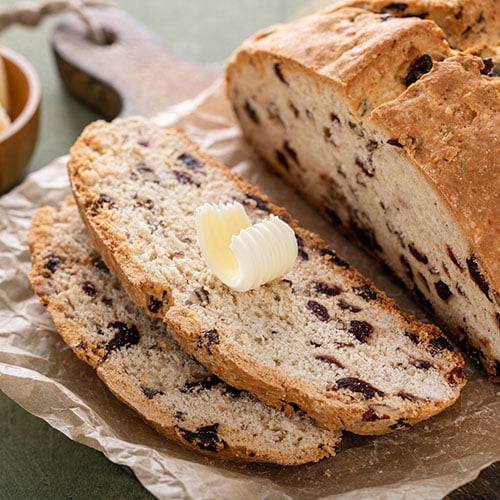
Irish soda bread is a rounded, domed bread that is made with baking soda as the leavening agent instead of yeast. Irish soda bread originated in Ireland and is one of the many dishes served as St. Patrick’s Day food.
Irish soda bread contains flour, buttermilk, baking soda, and salt. Usually, raisins and nuts are added in, too. This bread is crumbly and quite scone-like and is more so quick bread than classic artisan bread. The best way to eat Irish soda bread is by slicing it and spreading butter, jam, or marmalade on top.
- Irish Soda Bread Origin: Ireland
- Irish Soda Bread Ingredients: Flour, buttermilk, baking soda, salt, raisins, and nuts
- How to Eat Irish Soda Bread: Sliced and spread with butter, jam, or marmalade
Back to Top
11. Multigrain
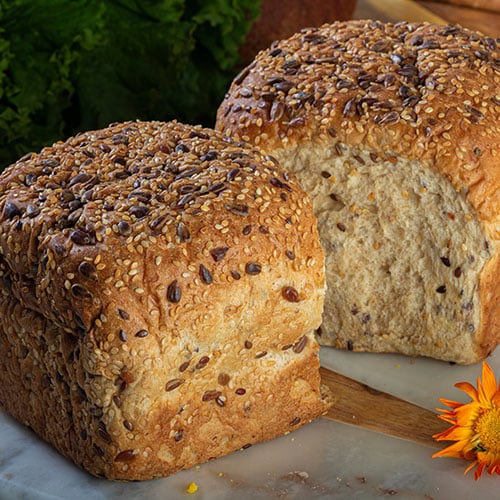
Multigrain is a type of bread that is regarded as a healthier bread option. It is believed that multigrain bread is from modern-day Iran, Iraq, and Turkey.
Multigrain bread can have different grains such as barley, whole wheat, oat, quinoa, millet, and flax flour. Seeds can be present too, such as pumpkin and sunflower seeds. Multigrain bread also contains flour, yeast, salt, water, and sometimes brown sugar. The hearty ingredients make it ideal for breakfast toast and sandwiches.
- Multigrain Bread Origin: Iran, Iraq, and Turkey
- Multigrain Bread Ingredients: Barley, whole wheat, oats, quinoa, millet, flax seeds, pumpkin seeds, sunflower seeds, flour, yeast, salt, water, and sometimes brown sugar
- How to Eat Multigrain Bread: Breakfast toasts and sandwiches
12. Naan
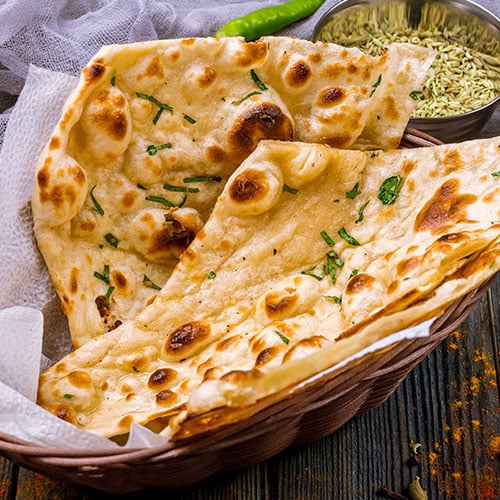
Naan is a type of leavened flatbread that originated in many parts of Western Asia, South Asia, Indonesia, and Malaysia. Naan is soft, chewy, and textured, and contains flour, water, sugar, yeast, yogurt, vegetable oil, and salt.
Naan is baked in a tandoor, which is a hot clay oven that can reach temperatures of 900 degrees Fahrenheit. Naan is usually served alongside West Asian and South Asian dishes such as regional curries.
- Naan Origin: Western Asia, South Asia, Indonesia, and Malaysia
- Naan Ingredients: Flour, water, sugar, yeast, yogurt, vegetable oil, and salt
- How to Eat Naan: Served alongside West Asian and South Asian dishes
13. Paratha
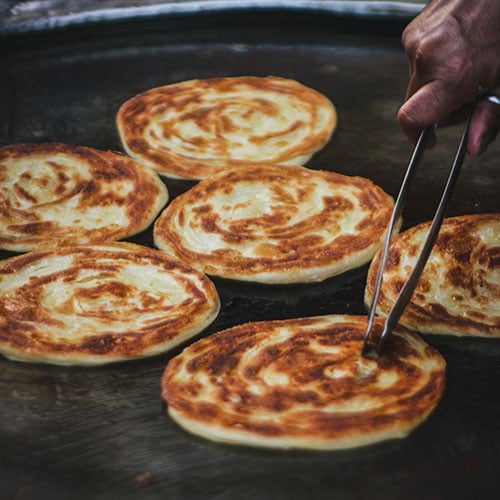
Parathas are unleavened flatbreads that originated in South Asia. Parathas are made of whole wheat flour (atta), water, salt, and ghee or oil. Each paratha is made by being rolled out, smothered with ghee, sprinkled with a bit of flour, rolled into a pinwheel shape, and rolled out again. This process creates a buttery and flaky flatbread.
Parathas are cooked in a tawa (a stone frying pan) and served warm. You can eat parathas just by themselves with a pat of butter. They’re also great with chutneys and pickles, served alongside dahl or curries, and they’re also typically made for the fan-favorite street food: kati rolls.
- Paratha Origin: South Asia
- Paratha Ingredients: Whole wheat flour (atta), water, salt, and ghee or oil
- How to Eat Parathas: By themselves with a pat of butter, served with chutney and pickles, alongside dahl or curries, or made into kati rolls
14. Pita
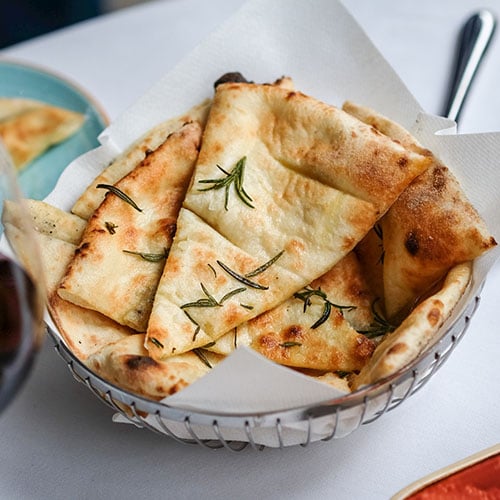
Pita bread is another flatbread that is leavened with yeast. It originated in the Middle East and is still used prominently in this region as well as the Mediterranean. Pita is made of flour, yeast, salt, water, and sometimes sugar, making it a little bit dry on the outside with a chewy interior.
Greek pitas are flat when baked, making them great for souvlaki. Middle Eastern pitas are baked in a very hot oven, which makes the water in the pita steam, causing the pita to rise and create a large pocket in the middle. These pitas are opened and stuffed with vegetables, hummus, and falafels, or served with kebabs.
- Pita Origin: Middle East
- Pita Ingredients: Pita is made of flour, yeast, salt, water, and sometimes sugar
- How to Eat Pita Bread: Greek souvlaki, Middle Eastern falafel sandwich, or served with kebabs
Naan vs Pita
Pita bread is similar to naan as they're both yeast-leavened flatbreads, but pitas have less enriched ingredients, making them a bit drier than naan.
15. Potato Bread
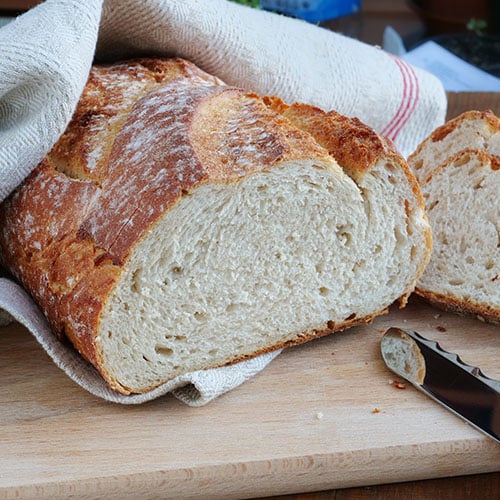
Potato bread is a type of Irish bread that uses mashed potatoes as one of the prominent ingredients – just like fastnachts! This creates a fluffy, moist, and fine-textured bread. Besides mashed potatoes, potato bread is also made of whole wheat flour, yeast, sugar, salt, eggs, and butter.
Although the potatoes replace some of the whole wheat flour in a bread recipe, it does not replace it all, which is why potato bread is usually not gluten-free. Potato bread is great for toast, sandwich bread, or dinner rolls.
- Potato Bread Origin: Ireland
- Potato Bread Ingredients: Mashed potatoes, whole wheat flour, yeast, sugar, salt, eggs, and butter
- How to Eat Potato Bread: Toast, sandwich bread, or dinner rolls
16. Quick Bread
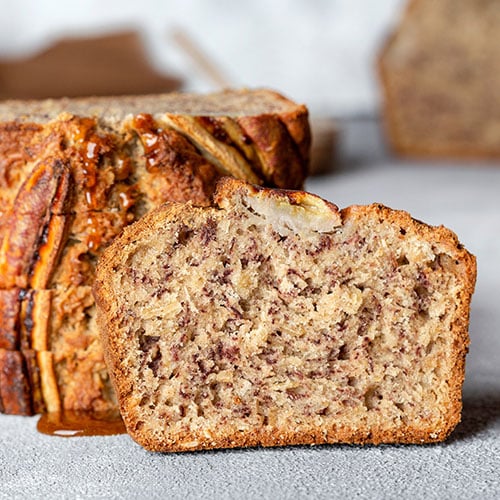
Quick bread is a type of bread that’s made with baking powder or baking soda as the leavening agent instead of yeast or sourdough starter. Muffins, cupcakes, cakes, certain donuts, banana bread, pumpkin bread, biscuits, scones, and cornbread are all considered quick bread.
Quick Bread vs Yeast Bread
Because quick bread uses chemical leavening agents in its doughs and batters, they do not require kneading or proofing as bread with yeast does. They can be baked right away.
What Are the Three Mixing Methods for Quick Bread?
The three mixing methods for quick bread are the muffin method, the creaming method, and the biscuit method.
- Muffin Method: The muffin method mixes all the wet ingredients separately and all the dry ingredients separately and are then combined to make the batter.
- Biscuit Method: The biscuit method is like the muffin method where the dry and wet ingredients are mixed separately and then combined, but the biscuit method adds in the fat differently by being cut into the dough to produce a flaky dough instead of a homogenous batter.
- Creaming Method: The creaming method is when butter and sugar are creamed together on high for about five minutes. The eggs and vanilla are added, followed by the dry ingredients alternating with the milk.
17. Rye Bread
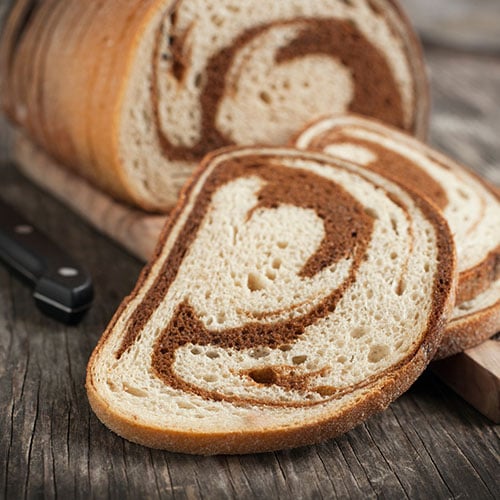
Rye bread is a type of bread that originated in Europe and is currently used in many Northern and Eastern European countries. Rye flour can be light or dark in color, and sometimes you’ll see loaves of rye bread that contain a swirl of both. Rye bread is made from rye flour, water, yeast, honey, caraway seeds, and salt, making it dense and more flavorful than most bread varieties thanks to rye flour.
Rye bread is best used for sandwiches. Because rye bread has such a distinct flavor, you’ll want to top it with pungent foods so the bread doesn’t overpower milder foods. Top rye bread with smoked fish and meats, sauerkraut, onions, strong cheeses, and eggs. Rye bread is famously used to make Reubens, too!
- Rye Bread Origin: Europe
- Rye Bread Ingredients: Rye flour, water, yeast, honey, caraway seeds, and salt
- How to Eat Rye Bread: Sandwiches such as Reubens
18. Sourdough
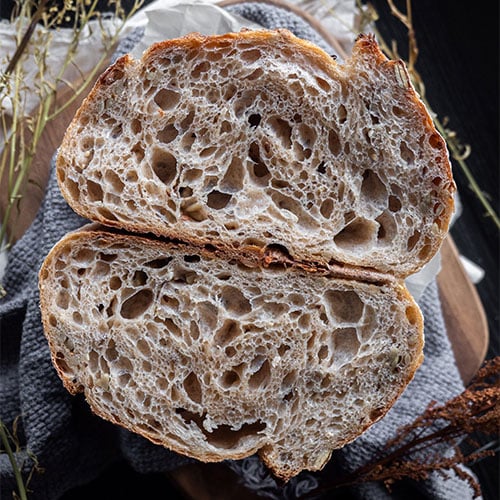
Sourdough is a type of bread that’s leavened with a sourdough starter. A sourdough starter is a mixture of flour and water that cultivates into a leavening agent. Not only does this fermentation process give sourdough its rise, but it also lends the desired “sour” note.
There are a lot of different claims for sourdough’s origin, with the most likely answer being Ancient Egypt as this was the first recorded place of sourdough. Sourdough uses flour, water, sourdough starter, and salt. Sourdough makes a great toast option as well as sandwich bread. It’s also a great table bread or accompaniment to any charcuterie board.
- Sourdough Origin: Ancient Egypt
- Sourdough Ingredients: Sourdough starter, flour, water, and salt
- How to Eat Sourdough: Toast, sandwich bread, and accompaniment to a charcuterie board
19. White Bread
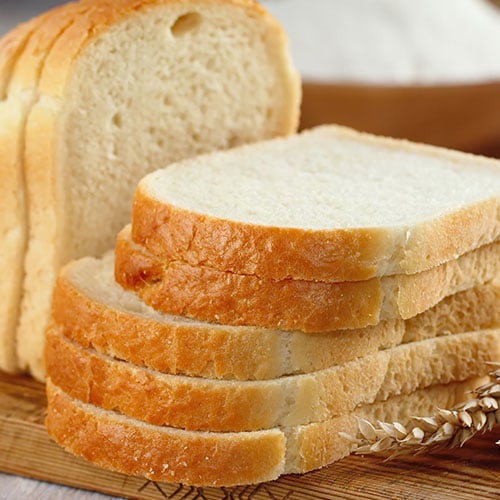
White bread is a type of bread that is made from whole wheat flour where the bran and germs have been removed from the wheatberry. This leaves the endosperm as the remaining ingredient, causing the bread to be lighter in color and texture, with less flavor and fewer nutrients.
It is believed that white bread was seen as early as Ancient Egypt’s civilization, where wheat was sifted to produce a pure white starch. White bread is made of all-purpose flour, yeast, water, sugar, salt, and butter. It's best for lunch sandwiches and tea sandwiches, casseroles, grilled cheeses, or turning into breadcrumbs or croutons.
- White Bread Origin: Ancient Egypt
- White Bread Ingredients: All-purpose flour, yeast, water, sugar, salt, and butter
- How to Use White Bread: Sandwiches, casseroles, grilled cheeses, or turned into breadcrumbs or croutons
20. Whole Wheat Bread
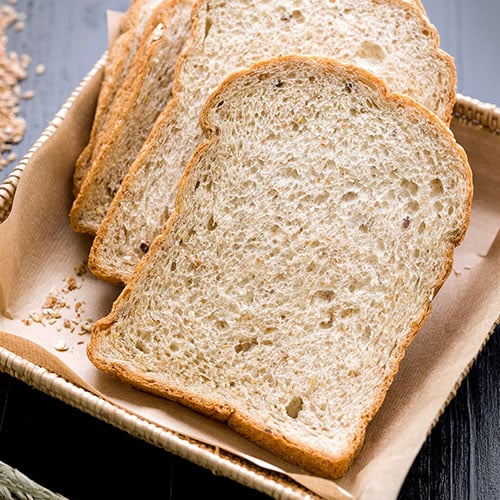
Whole wheat bread is a type of bread that uses whole wheat flour, which is a flour where the entire wheat grain is left intact. This produces darker, denser bread with more flavor and nutrients than white bread. Whole wheat bread is made from whole wheat flour, yeast, water, salt, honey or molasses, and sometimes milk.
Whole wheat bread was first made in the Fertile Crescent which is modern-day Iraq, Syria, Egypt, Israel, Jordan, Lebanon, and Palestine. Whole wheat bread is great for sandwiches, toast for bruschetta or brothy mussels and clam dishes, and also as croutons for a panzanella salad.
- Whole Wheat Bread Origin: Fertile Crescent
- Whole Wheat Bread Ingredients: Whole wheat flour, yeast, water, salt, honey or molasses, and sometimes milk
- How to Use Whole Wheat Bread: Sandwiches, toast, or as croutons
Back to Top
It’s amazing to see how just four inexpensive ingredients (water, flour, yeast, and salt) have had such a lasting influence in our world and across so many different cultures. The only factors that differentiate them are techniques, ratios, and other inclusions. Add any of these breads to your bakery or restaurant’s operations for a dish that everyone loves.




